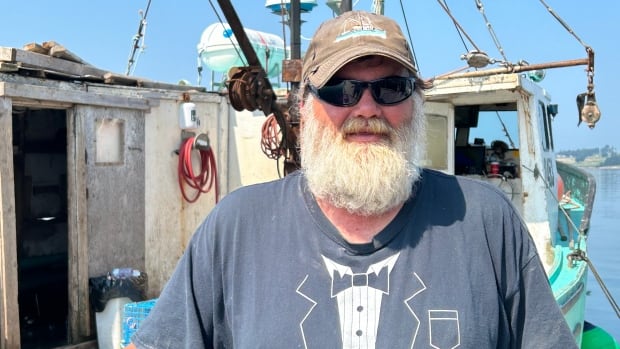As of Aug. 13, fishermen in New Brunswick were forced to pull their traps and stop fishing on 35 separate occasions this year after North Atlantic right whales were spotted.
But a new pilot program in the southwest is trying to keep lobster and crab boats on the water.
Crab fisherman Greg Beckerton and two lobster fishermen, Judson Mitchell and Peter Mawhinney, are testing five new types of ropeless gear, with the goal of choosing two for a wider test in the spring.
Traditional fishing gear uses rope that connects the traps on the ocean floor to a buoy on the surface.

With just 350 to 360 North Atlantic right whales believed to be left in the world, any time a whale is spotted an area is closed to fishing to prevent the threat of entanglement.
Beckerton hopes that alternative fishing gear that limits the use of traditional rope will allow fishing to continue when whales are in the area.
“In a closed-area situation we could use this gear, and it would definitely be an advantage,” he said.
Traps surface upon signal
With many closures over the past four years in his fishing area off Saint Andrews, Beckerton volunteered to be part of the scientific study, which is a partnership between the Fundy North Fishermen’s Association and the Canadian Wildlife Federation.
Fundy North Fishermen’s Association is testing ropeless, on-demand technology to keep lobster and crab fishers on the water during closures provoked by whale sightings.
Hanna Vatcher, a fishing gear technologist with the federation, spent a week with Beckerton on the water training him to use ropeless on-demand gear from five different manufacturers.
“I think it’s very important for harvesters to get their hands on this gear and see it working on their vessel,” she said. “At the end of the day, it helps the fisherman and and it helps the whales, and that’s what we’re all about.”
On-demand gear works via acoustic signals, said Vatcher.
Once traps are dropped into the water, they can be recalled by sending a signal from a cellphone, which releases the coiled rope and buoys.
Some models have balloons that inflate and lift the traps to the surface when the signal is sent.

“We’ve been working in different conditions. So yesterday was very foggy. It was hard to spot the buoys. Sometimes we could only see about 50 metres from us, but units still came up,” she said of the gear system tests.
“And to us, getting the system back on board is a success and that was happening a lot this week, which is great.”
Traps customized for Bay of Fundy
Vatcher and her colleagues are collecting data and will provide feedback to the gear developers as part of the study.
“We’ve definitely noticed some systems perform differently when they’re in stronger currents or stronger tides, and that’s something that we have to keep in mind.”
She said the reports will help developers make modifications to the gear to adapt to the unique conditions of the Bay of Fundy.

Darlene Norman-Brown is assistant director of the Fundy North Fishermen’s Association, which oversees all of southwestern New Brunswick, excluding Grand Manan Island.
She said this is a “vital project” for those who are consistently facing closures after North Atlantic right whale sightings.
“We have the highest tides in the world here, the strongest currents. So it is the most difficult conditions for this gear to be tried,” said Norman-Brown.
“If we don’t do this and then it’s mandated by the government that they need to acquire this gear, there’s a chance that they may end up putting money into something that could be perfect working in other areas, but won’t withstand the currents and the tides here.”

After Beckerton and the other two fishermen try the new types of gear, they will get together and choose the two they think have the most potential.
“We are hoping that they will all pick the same gear automatically, but if not, then … we will have them get together to compare notes and make a decision,” said Norman-Brown.
In the spring, crab and lobster fishermen will test the chosen two during the season.
Norman-Brown says once a ropeless on-demand system has been chosen, it will be up to individual fishermen to purchase units if they wish.
Not the end of traditional gear
She doesn’t foresee the on-demand ropeless systems completely replacing traditional gear, however, and said the goal of this testing is to find a solution that could be deployed during closures.
But Beckerton said many of his fellow fishermen worry this could be the end of their traditional equipment.

“A lot of them are scared that this is what we’re going to be made to go to,” he said. “I have had fellows ask me how it is going, and some of them didn’t like it when I say, ‘Well, it does work.'”
According to the Canadian Wildlife Federation, fishermen will need a special licence to use these systems during area closures.
“We certainly don’t want to see fishermen lose their livelihoods. It’s a very important industry in Atlantic Canada,” said Vatcher.
“We have a lot of empathy for fish harvesters who are going through a stressful time. So being able to help them keep fishing in a closure is super important.”








